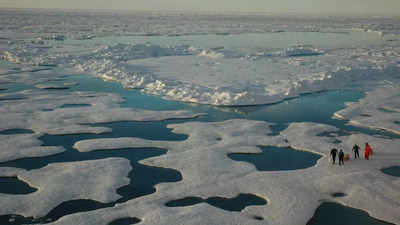
Image source: LiveScience The Arctic Circle , an extraordinary region covering 4% of Earth’s surface, is a land of extremes where the sun can shine at midnight or darkness may reign at noon. Despite its harsh conditions, this vast area is home to hundreds of thousands of people across eight countries, including the U.S.
(Alaska), Canada, Russia, Norway, Sweden, Finland, Denmark (Greenland), and Iceland. It boasts unique wildlife, such as the Arctic fox, and notable cities like Murmansk , the largest north of the Circle. The region is governed by the Arctic Council , focusing on sustainable development and environmental protection.
With dramatic landscapes and natural wonders like the Northern Lights, the Arctic Circle continues to fascinate, though its boundaries slowly retreat due to Earth's shifting axial tilt. Fascinating facts about the Arctic Circle There are eight countries in the Arctic Circle The Arctic Circle stretches from 66 to 67 degrees north. Alaska's Point Barrow is the northernmost point of the U.
S., but Canada, Russia, Norway, Finland, Sweden, Greenland, and Iceland all have land in the region. Arctic Circle is home to Arctic Fox The Arctic fox, with its thick fur and nomadic nature, travels across the entire region.
Its white coat provides natural camouflage from predators like polar bears and wolves. Murmansk, Russia: The largest city Murmansk, a Russian port with around 295,000 people, is the largest city in the Arctic. Norilsk, also in Russia, follows, known for mining and the Nord Kamal Mosque.
Tromsø, Norway, is the most populous city outside of Russia and is renowned for viewing the Northern Lights. The Arctic Council Established in 1996, the Arctic Council addresses sustainable development and environmental protection in the region. Military issues are excluded from its mandate.
The Arctic doesn't plunge into complete darkness Even during the polar night, communities still experience twilight. For example, in Utqiaġvik, Alaska, the sun doesn’t rise for 65 days, but twilight still lasts for three to six hours daily. The sun shines for months In the North Pole, the sun rises during the spring equinox in March and doesn’t set until September, earning the Arctic the nickname "Land of the Midnight Sun.
" In Tromsø, Norway, this phenomenon lasts for about two months. The Antarctic Circle is colder While the Arctic's average winter temperature is minus 40°F (minus 40°C), the Antarctic is far colder at minus 76°F (minus 60°C) in winter due to the South Pole's lack of moderating seawater. Unlike the Arctic, the Antarctic Circle has no permanent human settlements.
The Arctic Circle centre The Arctic Circle Centre in Norway is a great tourist spot with breathtaking views, a cafe, and a gift shop, though it’s not open year-round. The Arctic Circle is shrinking Earth's axial tilt is shifting, causing the Arctic Circle’s boundary to retreat by 46 to 49 feet (14 to 15 metres) annually, altering the region over time. Also Read | Greenest countries in the world 2024: Germany, Sweden, Denmark and more.








